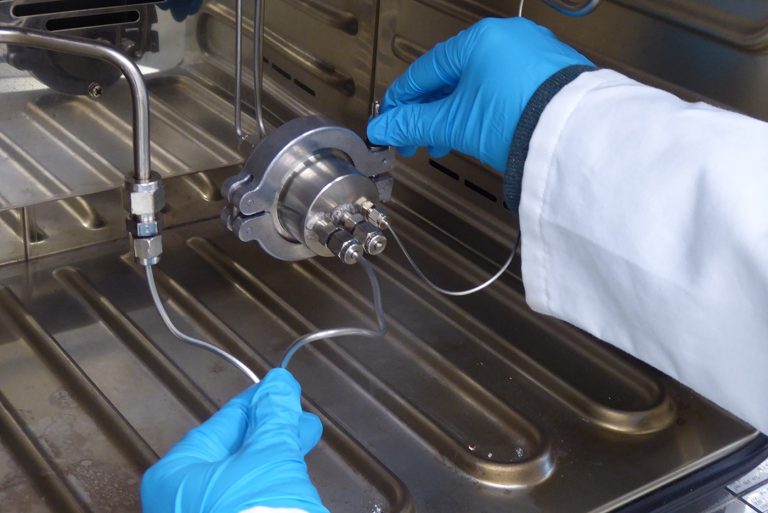TU researchers have developed a new type of H2-separation membrane with promising properties for industrial applications.


The euro-sized sample in the white laboratory in the Applied Sciences building may be small but the promises are huge. This newly developed membrane, on top of a porous aluminium oxide substrate, combines a high selectivity for hydrogen with large permeability. Under high pressure and temperature industrial conditions, the membrane selectively lets small hydrogen molecules pass, but stops most of the carbon dioxide.
Hydrogen filters are required for various industrial processes such as hydrogen production and purification, CO2 capture after water gas shift processes, and reducing the energy intensity of ammonia synthesis for fertilisers.
Professor Freek Kapteijn (Faculty of Applied Sciences) says that a large number of different membranes have been developed over the years in the search for alternatives for the ubiquitous polymer membranes that suffer from a trade-off between selectivity and gas permeability.
Now, a new type of polymer called BILP (Benzimidazole-linked polymer) has been developed that combines thermal and chemical stability with narrow pores that makes it suitable for the separation of small molecules. Researchers from the TU Delft Catalysis Engineering group, together with international colleagues, published their results in Science last week.
The difficulty with BILPs is that they are nonsoluble, making them hard to handle. The solution, if you will, has been to synthesise the BILP membrane on top of a porous aluminium oxide disk soaked in aqueous solution with one component, which was then dried and exposed to an organic solution with the other component. Half a micron of membrane then formed at the interface.


Dr Xinlei Liu and PhD candidate Meixia Shan have tested the oxide-backed membrane with gas mixtures in the laboratory at 150 degrees Celsius for 800 hours. They found that, if the initial gas mix ratio CO2:H2 is 1:1, it will be 1:40 behind the filter. That is double the selectivity of existing membranes.
The researchers conclude that this high H2/CO2 separation performance, in combination with long-term stability, makes BILP membranes a promising candidate for hydrogen separation and purification under industrial conditions.
This doesn’t mean BILPs will be applied at a large scale any time soon, says Professor Kapteijn. Due to the large investments tied up in industrial installations, the absorption rate of innovative processes is usually slow in the chemical and petrochemical industries.


Professor Freek Kapteijn retired on Friday 28 September, the day he attended a large international symposium on catalysis engineering.
PhD candidate Meixia Shan will defend her thesis and discuss the article below on 24 October.
- Meixia Shan, Xinlei Liu1, Xuerui Wang, Irina Yarulina, Beatriz Seoane, Freek Kapteijn and Jorge Gascon, Facile manufacture of porous organic framework membranes for precombustion CO2 capture, 21 September 2018.
Do you have a question or comment about this article?
j.w.wassink@tudelft.nl


Comments are closed.